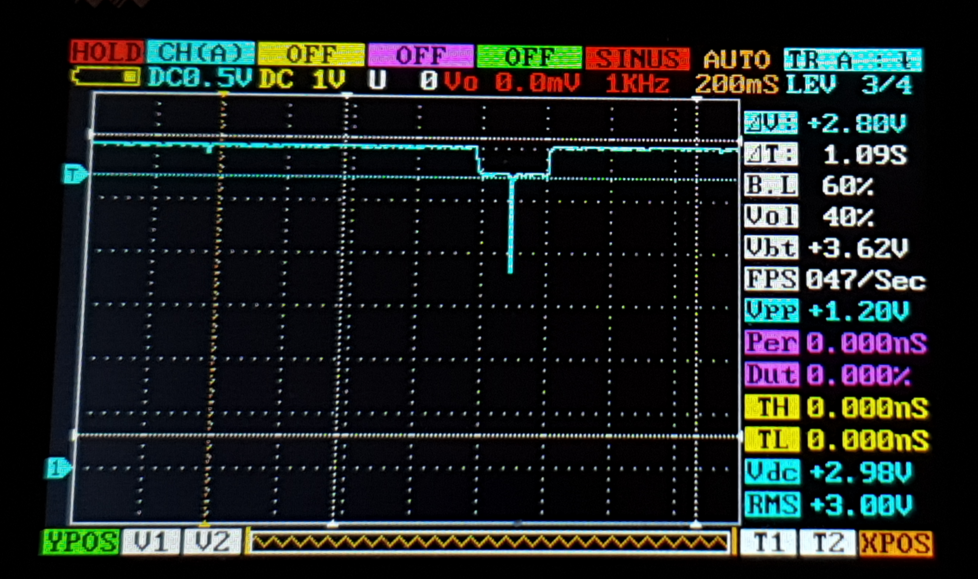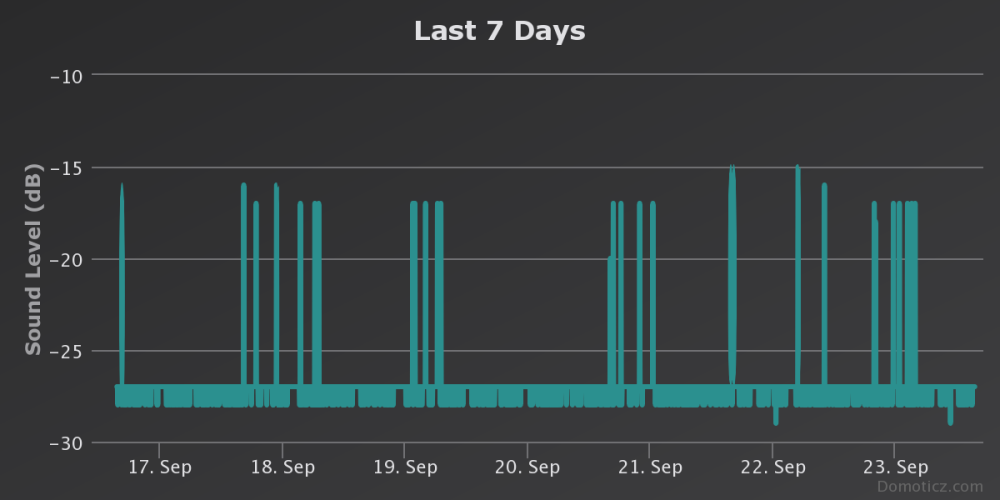RFM69HW RSSI / range problems
-
Hey!
I'm new to MySensors, and very hapy that this open project exist.
Unfortunately, I have problems with RMF69HW 433MHz modules (ebay), however from all threads I have read I'm not alone.CSMA routine seems does not work as expected, every single packet it fails and runs out to timeout.
I'm usually getting RSSI values in CSMA routine between -80 to -90.
short example:
1818842 RFM69:CSMA:RSSI=-83
1818846 RFM69:CSMA:RSSI=-83
1818849 RFM69:CSMA:RSSI=-87
1818853 RFM69:CSMA:RSSI=-87
1818856 RFM69:CSMA:RSSI=-88
1818860 RFM69:CSMA:RSSI=-84
1818864 RFM69:CSMA:RSSI=-85
1818867 RFM69:CSMA:RSSI=-88
1818871 RFM69:CSMA:RSSI=-87
1818874 RFM69:CSMA:RSSI=-86But CSMA has predefined "silence" value as -95 in file RFM69_new.h
#define MY_RFM69_CSMA_LIMIT_DBM (-95)From all my tries it looks like PowerAmplifier (PA) is all time turned on and makes noise for the RX.
Range of my modules is low, usually one wall is too much to communicate. Only inside of one room they work well.
I'm not using any other 433MHz technology in the house which could posiibly make that high RSSI values.I'm using example scatches from MySensors with this custom predefinitions:
#define MY_RADIO_RFM69
#define MY_IS_RFM69HW
#define MY_RFM69_FREQUENCY (RFM69_433MHZ)
#define MY_RFM69_NEW_DRIVER
#define MY_DEBUG_VERBOSE_RFM69I have tamporarily increased MY_RFM69_CSMA_LIMIT_DBM limit to -70, however this is not solution of problem, just surpessing of symptom..
Can somebody local, with good working RFM69HW module confirm, that his values of RSSI in CSMA routine are usually below -95?
-
Hey!
I'm new to MySensors, and very hapy that this open project exist.
Unfortunately, I have problems with RMF69HW 433MHz modules (ebay), however from all threads I have read I'm not alone.CSMA routine seems does not work as expected, every single packet it fails and runs out to timeout.
I'm usually getting RSSI values in CSMA routine between -80 to -90.
short example:
1818842 RFM69:CSMA:RSSI=-83
1818846 RFM69:CSMA:RSSI=-83
1818849 RFM69:CSMA:RSSI=-87
1818853 RFM69:CSMA:RSSI=-87
1818856 RFM69:CSMA:RSSI=-88
1818860 RFM69:CSMA:RSSI=-84
1818864 RFM69:CSMA:RSSI=-85
1818867 RFM69:CSMA:RSSI=-88
1818871 RFM69:CSMA:RSSI=-87
1818874 RFM69:CSMA:RSSI=-86But CSMA has predefined "silence" value as -95 in file RFM69_new.h
#define MY_RFM69_CSMA_LIMIT_DBM (-95)From all my tries it looks like PowerAmplifier (PA) is all time turned on and makes noise for the RX.
Range of my modules is low, usually one wall is too much to communicate. Only inside of one room they work well.
I'm not using any other 433MHz technology in the house which could posiibly make that high RSSI values.I'm using example scatches from MySensors with this custom predefinitions:
#define MY_RADIO_RFM69
#define MY_IS_RFM69HW
#define MY_RFM69_FREQUENCY (RFM69_433MHZ)
#define MY_RFM69_NEW_DRIVER
#define MY_DEBUG_VERBOSE_RFM69I have tamporarily increased MY_RFM69_CSMA_LIMIT_DBM limit to -70, however this is not solution of problem, just surpessing of symptom..
Can somebody local, with good working RFM69HW module confirm, that his values of RSSI in CSMA routine are usually below -95?
@dell640 said in RFM69HW RSSI / range problems:
Can somebody local, with good working RFM69HW module confirm, that his values of RSSI in CSMA routine are usually below -95?
Yes, if You have properly designed your node/gateway. I had exactly same problem when I was powering the rfm module from 3.3v pin of the rasberry pi. Using separate LDO for the rfm module reduced the RSSI values to around -100dBm. Use low noise LDO, keep power paths short and use decoupling capacitors and it should make things better.
-
@dell640 said in RFM69HW RSSI / range problems:
Can somebody local, with good working RFM69HW module confirm, that his values of RSSI in CSMA routine are usually below -95?
Yes, if You have properly designed your node/gateway. I had exactly same problem when I was powering the rfm module from 3.3v pin of the rasberry pi. Using separate LDO for the rfm module reduced the RSSI values to around -100dBm. Use low noise LDO, keep power paths short and use decoupling capacitors and it should make things better.
@rozpruwacz said in RFM69HW RSSI / range problems:
Yes, if You have properly designed your node/gateway. I had exactly same problem when I was powering the rfm module from 3.3v pin of the rasberry pi. Using separate LDO for the rfm module reduced the RSSI values to around -100dBm. Use low noise LDO, keep power paths short and use decoupling capacitors and it should make things better.
Thanks for your hint, my nodes are powered from (relatively) strong power sources (5V/2A), not Pi pins. Tested node is powered from 3.3V LDO Regulator (has 100uF output capacitor) and shared is only with Atmega328p.
However I have to confirm your presumption, power have strong drop downs, which is most probably causing this problems (actually I dont understand how the ATMEGA itself could work with theese dropouts...)
I will come back with results.
Thx

-
I have rebuild my custom setups in order to have most "clean" and strong power lines. I have to confirm, that now nodes are able to find RSSI values approx -95 to -98 in CSMA routine, so It basically works...even if it is far far away from datasheet value of -120dB
However there is still problem with range, one brick wall makes connection very unstable. Device at 433MHz with 110dB (-90 to 20) ling budget should work much better.
In the tests I have disabled ATC mode by:
#define MY_RFM69_ATC_MODE_DISABLEDand set power level to maximum:
#define MY_RFM69_TX_POWER_DBM (20)two nodes, close each other (approx. 10cm) reaches usually connection RSSI between -30 to -20. using helical 1/4 antennas (ebay).
Are these values usual? Or the PA on the board is not working as expected? -
I have rebuild my custom setups in order to have most "clean" and strong power lines. I have to confirm, that now nodes are able to find RSSI values approx -95 to -98 in CSMA routine, so It basically works...even if it is far far away from datasheet value of -120dB
However there is still problem with range, one brick wall makes connection very unstable. Device at 433MHz with 110dB (-90 to 20) ling budget should work much better.
In the tests I have disabled ATC mode by:
#define MY_RFM69_ATC_MODE_DISABLEDand set power level to maximum:
#define MY_RFM69_TX_POWER_DBM (20)two nodes, close each other (approx. 10cm) reaches usually connection RSSI between -30 to -20. using helical 1/4 antennas (ebay).
Are these values usual? Or the PA on the board is not working as expected? -
@dell640 at 10cm the antennas are within eachother's near field of RF propagation. No numbers from datasheets will be relevant in the near field. The antennas need to be at least one wavelength (70cm/2.3ft) apart.
@mfalkvidd said in RFM69HW RSSI / range problems:
@dell640 at 10cm the antennas are within eachother's near field of RF propagation. No numbers from datasheets will be relevant in the near field. The antennas need to be at least one wavelength (70cm/2.3ft) apart.
Thanks for that. Its pretty theotertical stuff, however it is fact.
There is no change in RSSI if I'm moving the nodes more far or close. RSSI keeps in same range of -20 to -30dB in range of approx 2 meters...then it of course going down...Are these RSSI values maximum for RFM69HW?
Do I understand right, that receiving RSSI values should be = 20dBm - TX antenna gain/loss - transmission loss - RX antenna gain/loss --> RSSI at zero values at the minimum? -
@mfalkvidd said in RFM69HW RSSI / range problems:
@dell640 at 10cm the antennas are within eachother's near field of RF propagation. No numbers from datasheets will be relevant in the near field. The antennas need to be at least one wavelength (70cm/2.3ft) apart.
Thanks for that. Its pretty theotertical stuff, however it is fact.
There is no change in RSSI if I'm moving the nodes more far or close. RSSI keeps in same range of -20 to -30dB in range of approx 2 meters...then it of course going down...Are these RSSI values maximum for RFM69HW?
Do I understand right, that receiving RSSI values should be = 20dBm - TX antenna gain/loss - transmission loss - RX antenna gain/loss --> RSSI at zero values at the minimum? -
@dell640
unfortunately these are theoretical datasheet values. If you want to get best rf efficiency, you would need to check your antenna tuning, and most important point have a huge gnd plane for 433mhz.
Don't forget gnd plane is a part of your antenna. Not taking into account this can lead to bad VSWR ratio and antenna efficiency..
With a not optimal gnd plane I already got +50meters outside range with one concrete wall obstacle.
"Not a lot" of range, but setup was with non optimal hw (since then I learnt more about rf) :- rfm69hw 868mhz GW was indoor with straight "wire" antenna for test (custom usb dongle in rpi), approx 1.2meter above ground
- and the outdoor node was rfm69cw 868mhz with coiled antenna, batt powered (non optimal gnd plane), approx 1.5meter above ground.
https://forum.mysensors.org/topic/8813/any-success-story-on-lora-rfm95-module-and-mysensors/21
As you can see, it's easy to waste efficiency and range..thus datasheets only numbers are useless. -
@mfalkvidd
Thanks! That is almost the same as my readings.@scalz
I have been working few years with ZigBee modules from TI (CC2530). I had dozens of different setups with integrated and also external antenna. RF values was not "just datasheet numbers", if there was written 20dBm output, it was there.
But fully agree, that here is the problem mainly caused by non-optimized antenna... So there is a huge space to increase the range of modules...And one more update, whch I think can be very important for all others. My setup is running on OpenHab2 installed on OrangePi Zero with SerialGateway connected over UART.
Just now I had realised, that OrangePi makes huge RF noise. If I will run setup normally, receiving sensitivity is very poor. Once I start setup without SD card inside of the system (OrangePi will not start up), Arduino gateway is receiving perfectly.
I have just putted SerialGateway to the 50cm long cables, far from OrangePi and usable range is more than twice longer than before.Thans for your time guys. Appreciated. :clap:

